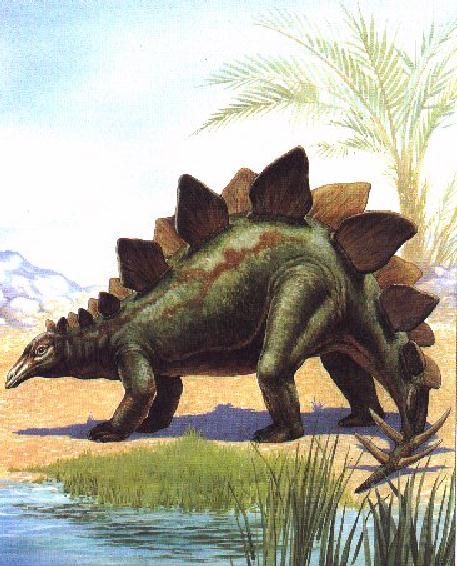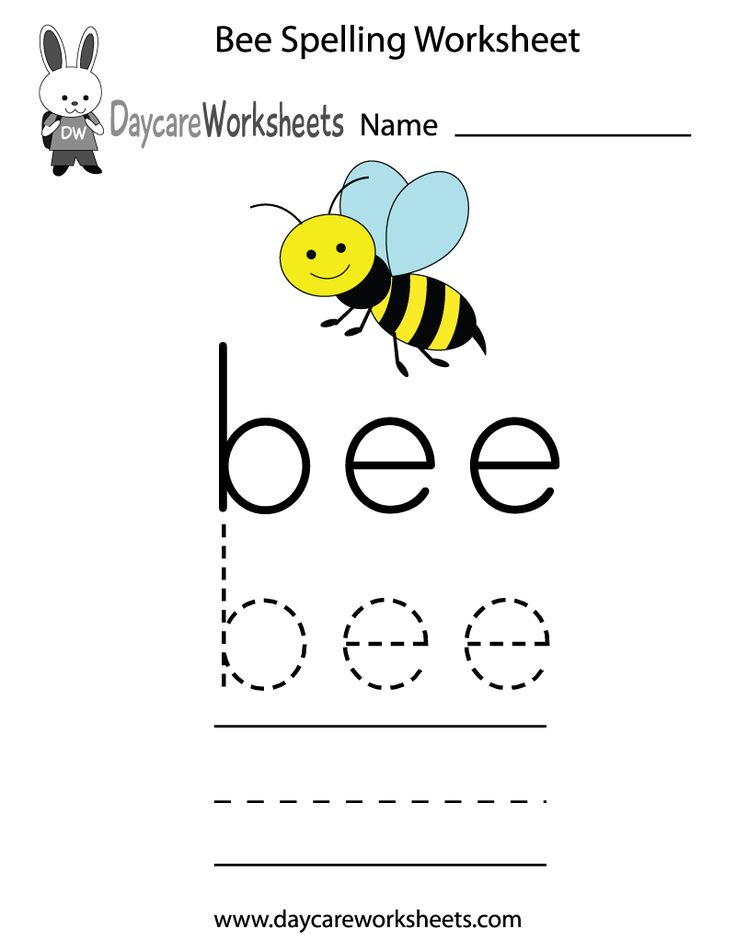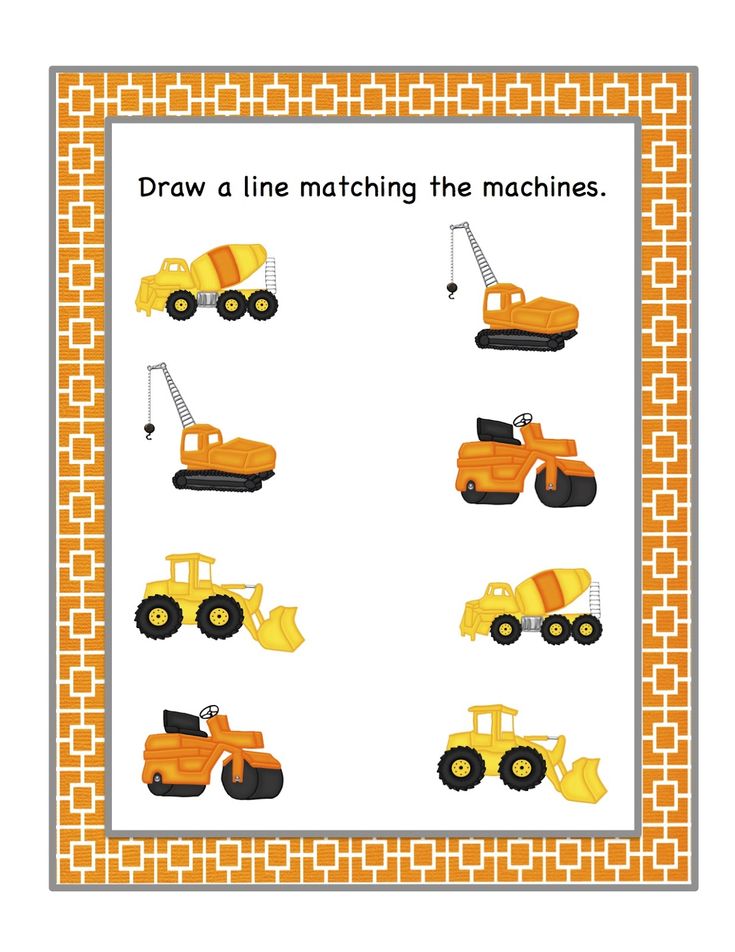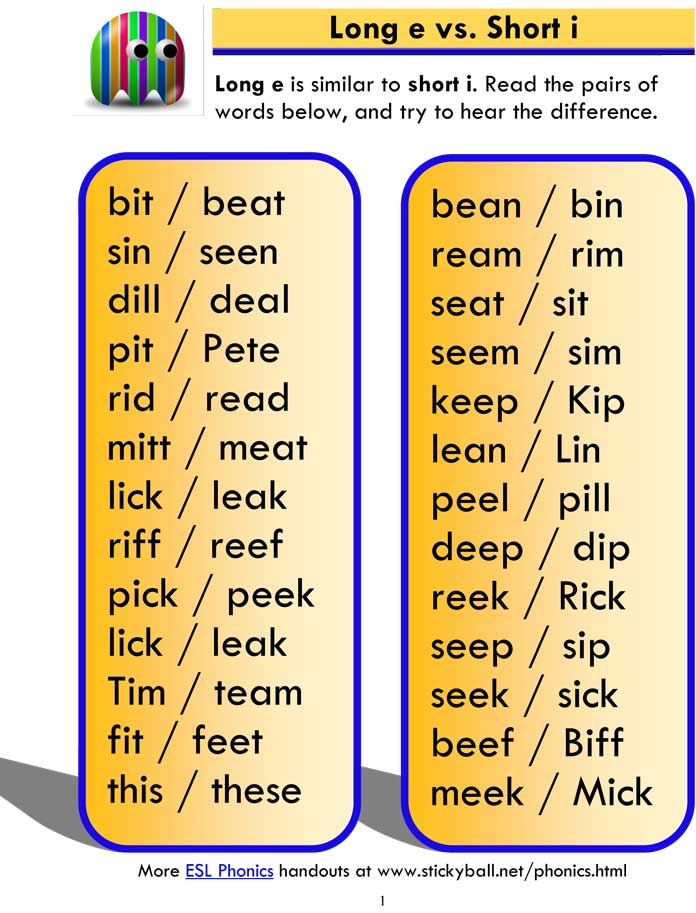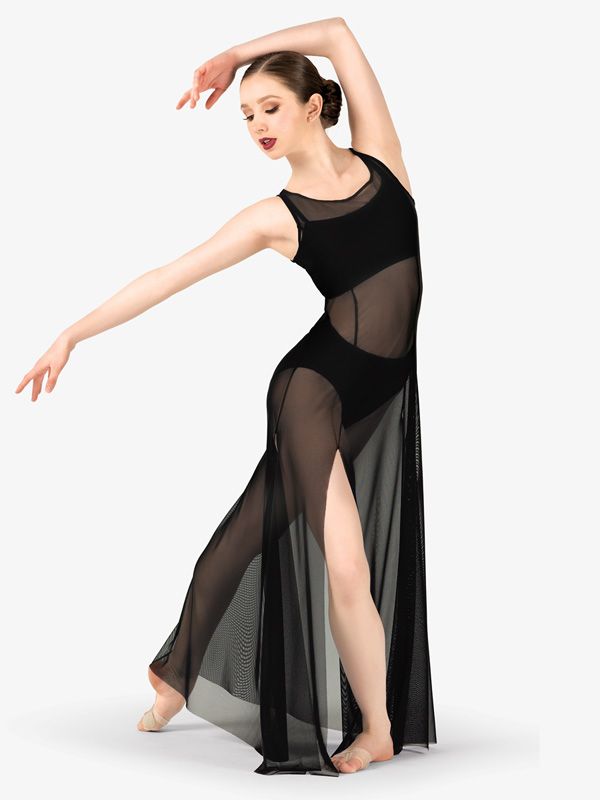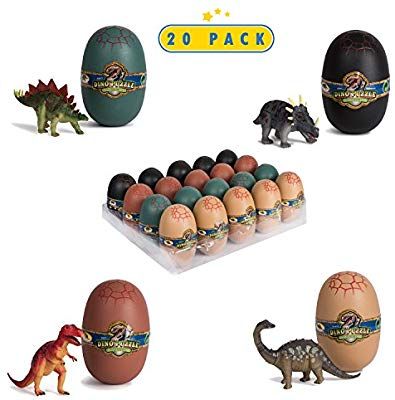What did the stegosaurus eat
Description, Habitat, Image, Diet, and Interesting Facts
The Stegosaurus is another famous dinosaur species that has captivated our imagination. Much of their notoriety comes from their odd, and intriguing, appearance.
The name Stegosaurus roughly translates to “roof lizard,” which only makes sense if you know what they look like! These dinosaurs had large flattened plates along the ridges of their backs. Read on to learn about the stegosaurus.
Description of the Stegosaurus
There were three different species of Stegosaurus, but all were relatively similar looking. Overall, these creatures were short, stout, and powerfully built. They walked on four short legs, had small heads, and long tails capped with defensive spines.
A line of flattened, plate-like spines ran down their backs. The largest species could grow nearly 30 ft. long and weigh up to 7 metric tons.
Interesting Facts About the Stegosaurus
Though they were large by our standards, the other dinosaurs that roamed while Stegosaurus was alive dwarfed it. Simply put, 150 million years ago, some incredibly large creatures walked the earth. Learn how Stegosaurus survived below.
- Plate Debate – Scientists still aren’t quite sure what the large plates along the back of this dinosaur were actually used Though some believe the plates functioned as armor, many debate this, as the plates leave the sides of the animal unprotected. Other theories include making the animal look bigger, sexual displays, and thermoregulation.
- Thagomizer – These creatures weren’t without defenses. At the end of their tail they had four pointed spikes. Stegosaurus’ tail was extremely muscular, and they could forcibly swing these tail spikes into potential predators.
- Cheeky Chewer– Stegosaurus was one of the very first creatures to develop primitive cheeks. The development of cheeks allowed creatures to thoroughly chew their food before swallowing. This gave them the ability to eat more vegetation than other herbivores at the time, because the food was pre-digested when it hit the stomach.

- Butt Brain – These dinosaurs did not have the largest brains. In fact, they had one of the smallest brains of all dinosaurs in comparison to their body size. At one point, this actually led scientists to speculate that they might have additional brain matter in an area near their hips. Basically, they theorized that Stegosaurus had a brain near its butt. While this is possible, it is highly unlikely.
Habitat of the Stegosaurus
Fossils of this dinosaur are actually relatively rare, and because of this we can only speculate the other habitats this creature lived in. Archaeologists found the most specimens in the Morrison Formation, which we have decent information about the ecosystem of during that time.
We know they lived in areas that were semiarid, with a wet season and a dry season. There were flat floodplains, savannas dominated by ferns and the occasional tree, and forests.
Distribution of the Stegosaurus
Determining the extent of this creature’s range is difficult to do, because their fossils are somewhat rare.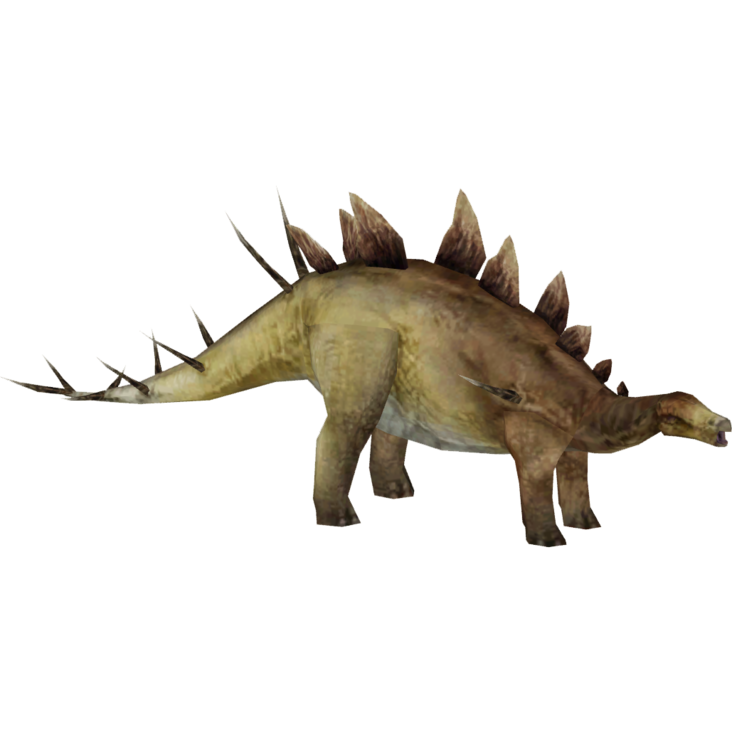 Researchers found many North American specimens in Colorado, Utah, and Wyoming. They found other fossils in Europe, China, Africa, and India. This suggests that the different Stegosaurus species were relatively widespread.
Researchers found many North American specimens in Colorado, Utah, and Wyoming. They found other fossils in Europe, China, Africa, and India. This suggests that the different Stegosaurus species were relatively widespread.
Diet of the Stegosaurus
We know that this dinosaur was herbivorous based upon its teeth. However, it has some pretty oddly shaped teeth and jaws. Scientists aren’t exactly sure how they chewed and foraged for food, because their mouth is simply, weird.
They do estimate that they fed on a number of different plant types, including ferns, moss, fruits, cycads, conifers, and horsetails. Grasses did not evolve until much later, so these dinosaurs would never have grazed on grasses.
Stegosaurus and Human Interaction
Stegosaurus went extinct around 150 million years ago, and never lived while humans were on earth. The only interactions between Stegosaurus and humans are in movies and television. These are, of course, digital or animatronic dinosaurs.
Domestication
Humans never domesticated Stegosaurus in any way, and never interacted with these extinct creatures.
Does the Stegosaurus Make a Good Pet
Even if they were alive, Stegosaurus would not make a good pet. They are somewhat small for dinosaurs, but they are definitely way too big to live in your house! It would be blatantly impossible to own one as a pet, even in theory.
Stegosaurus Care
In a zoological setting, these creatures would probably require care similar to rhinos or elephants. They are powerful animals, and would need strongly reinforced fencing for their enclosures.
Browsing on a wide variety of plants would be essential. Because they had very small brains, reliance on environmental enrichment would be much less pressing than in hyper-intelligent species like elephants.
Behavior of the Stegosaurus
Unfortunately, fossils do not provide much insight into the behavior of an animal. We can use rock formations to determine habitat, and damaged fossils to speculate interactions between animals, but beyond that all behavior is speculative.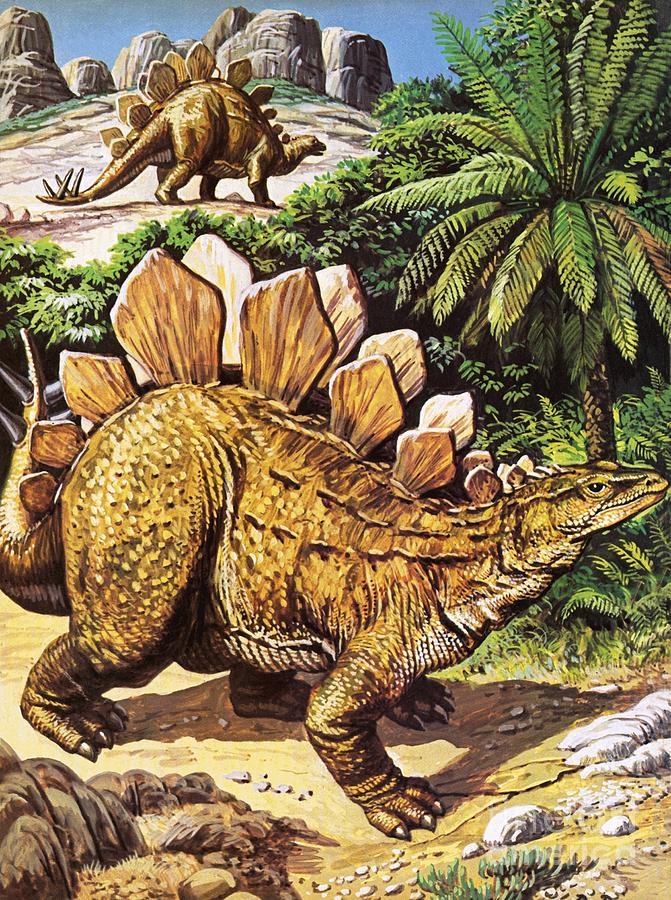
These creatures were large, and had incredibly small brains. It is likely that their life consisted pretty much of slowly searching for food, and defending themselves from predators.
Reproduction of the Stegosaurus
We know very little about the reproduction of these dinosaurs. Scientists believe they reproduced sexually, via mating, and laid eggs. Some theories suggest that the large plates on their back could change color as a mating display or to attract a female. As to the number of eggs, incubation time, and parental care, we simply don’t know yet.
Stegosaurus: Bony Plates & Tiny Brain
Live Science is supported by its audience. When you purchase through links on our site, we may earn an affiliate commission. Here’s why you can trust us.
Stegosaurus lived in the late Jurassic Period. (Image credit: <a href="http://www.shutterstock.com/gallery-259777p1.html">Ozja</a> | <a href="http://www.shutterstock.com/">shutterstock.com</a>)Stegosaurus was a large, plant-eating dinosaur that lived during the late Jurassic Period, about 150.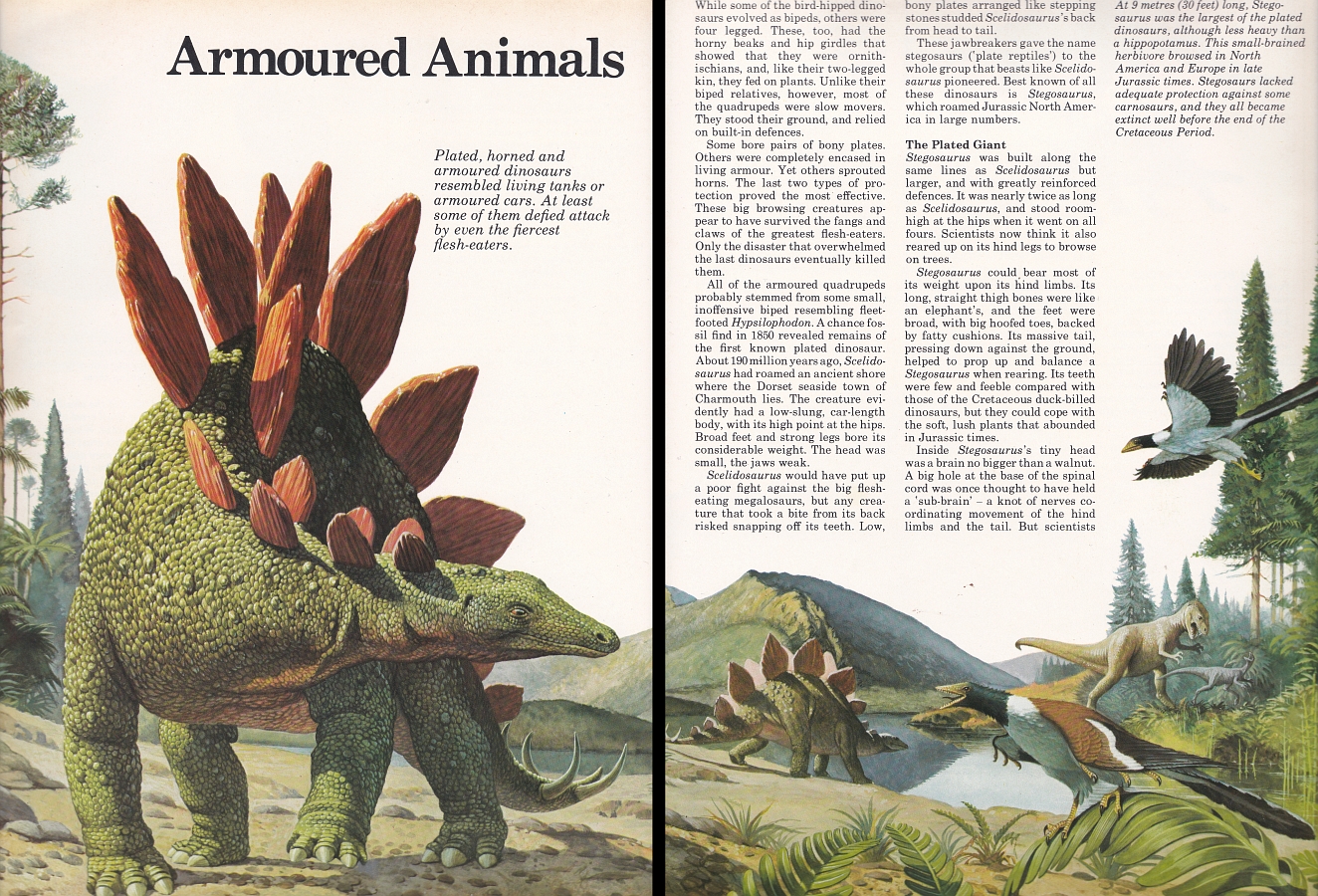 8 million to 155.7 million years ago, primarily in western North America. It was about the size of a bus and carried around two rows of bony plates along its back that made it appear even bigger.
8 million to 155.7 million years ago, primarily in western North America. It was about the size of a bus and carried around two rows of bony plates along its back that made it appear even bigger.
Stegosaurus is a bit of media darling because there is so much material to help scientists reconstruct its distinctive appearance. It has been depicted on television and in movies, most notably chasing Faye Wray in "King Kong" and appearing in the second and third installments of the "Jurassic Park" films. A newspaper cartoon even helped name one of its body parts.
Stegosaurus has a reputation for having a small brain and one of the lowest-brain-to-body ratios among dinosaurs. "The brain of Stegosaurus was long thought to be the size of a walnut," said armored dinosaur expert Kenneth Carpenter, director of the USU Eastern Prehistoric Museum in Utah. "But actually, its brain had the size and shape of a bent hotdog."
At one point scientists theorized that it had an auxiliary "brain" — not an actual brain but a bundle of nerves — above its rear legs to help control its movements because its brain was so small. This idea stemmed from the fact that the dinosaur had an enlarged canal in the pelvic region of its spinal cord, Carpenter said. However, that theory has since been rejected, and it is unclear what function this cavity served. It may have held a glycogen body, a structure found in birds that may play a role in energy storage, according to study published in the journal Paleobiology in 1990.
This idea stemmed from the fact that the dinosaur had an enlarged canal in the pelvic region of its spinal cord, Carpenter said. However, that theory has since been rejected, and it is unclear what function this cavity served. It may have held a glycogen body, a structure found in birds that may play a role in energy storage, according to study published in the journal Paleobiology in 1990.
Size of Stegosaurus
Stegosaurus was the largest and most well-known member of the Stegosauridae family of armored dinosaurs. The largest species was Stegosaurus armatus, a behemoth that grew up to about 30 feet (9 meters) long. It is considered a "type species," or the species that serves as the primary example of the Stegosaurus genus. However, Stegosaurus stenops — the best known and most studied Stegosaurus species due to its abundance of fossils, including a near-complete skeleton — may instead be more deserving of that title, Carpenter and paleontologist Peter Galton have argued in respective papers in the Swiss Journal of Geosciences in 2010.
There is also considerable debate regarding how many valid species of Stegosaurus exist, Carpenter told Live Science. On the one hand, there may be up to three or four species based on the differences seen in fossils. But if you're a "taxonomic clumper," you may think there's only a single species of Stegosaurus because a wide range of variation can exist within a single species (such as how all dog breeds belong to Canis lupus familiaris), Carpenter said.
Stegosaurus means "roofed lizard," which was derived from the belief by 19th-century paleontologists that the plates lay flat along its back like shingles on a roof. But most evidence supports the idea that the plates alternated in two rows, pointy side up from the dinosaur's neck down to its rear. Its 17 plates, called scutes, were made of a bony material called osteoderms but were not solid; they had lattice-like structures and blood vessels throughout.
Though it is uncertain what purpose the plates served, the blood vessels within the plates suggest temperature regulation (heat dissipation) was likely one function. However, that theory has been questioned — the microstructure of the plates suggests they weren't used to radiate heat, according to a 2005 analysis published in the journal Paleobiology. A more recent study, published 2010 in the Swiss Journal of Geosciences, concluded that the plates may have played a passive role in managing body temperature because of their large size and extensive blood vessels (similar to the way a toucan's large bill naturally radiates body heat), but that wasn't their primary function.
However, that theory has been questioned — the microstructure of the plates suggests they weren't used to radiate heat, according to a 2005 analysis published in the journal Paleobiology. A more recent study, published 2010 in the Swiss Journal of Geosciences, concluded that the plates may have played a passive role in managing body temperature because of their large size and extensive blood vessels (similar to the way a toucan's large bill naturally radiates body heat), but that wasn't their primary function.
Instead, Stegosaurus likely used its plates for display purposes. "Showing off, species recognition, attracting mates — that sort of thing," Carpenter explained.
Stegosaurus also had spikes at the end of its flexible tail, which pointed outward from the sides. Scientists began informally calling the spikes thagomizers after a pop culture reference in 1982, when a "Far Side" cartoon showed a group of cavemen calling the sharp spikes thagomizers "after the late Thag Simmons," according to New Scientist .
Experts think these spikes were used for defense against predators because of two lines of evidence. For one thing, about 10 percent of spikes found are damaged at the tip, Carpenter said. Additionally, scientists have found allosaur fossils (Stegosaurus's main predator) with puncture wounds from thagomizers.
Stegosaurus' long skull was pointed and narrow. It had an unusual head-down posture because it had forelimbs that were short in relation to its hind legs.
This leg-length imbalance suggests the dinosaur couldn't move very fast, because the stride of its back legs would have overtaken its front legs.
What did Stegosaurus eat?
Stegosaurus was an herbivore, as its toothless beak and small teeth were not designed to eat flesh and its jaw was not very flexible. Interestingly, unlike other herbivorous, beaked dinosaurs (including Triceratops and the duck-billed Hadrosaurids), Stegosaurus did not have strong jaws and grinding teeth.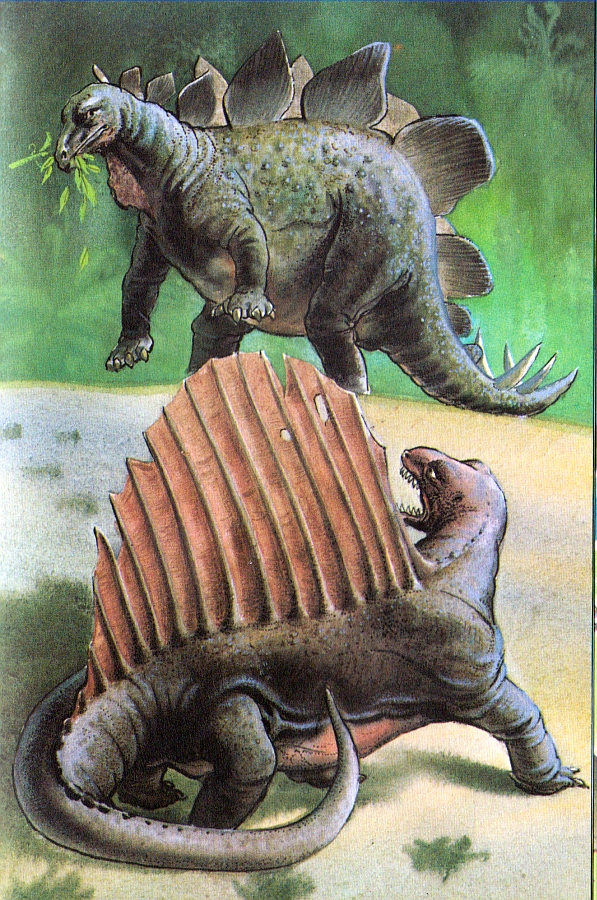 Instead, its jaws likely only allowed up and down movements, and its teeth were rounded and peglike. It also had cheeks, which gave it room to chew and store more food than many other of dinosaurs.
Instead, its jaws likely only allowed up and down movements, and its teeth were rounded and peglike. It also had cheeks, which gave it room to chew and store more food than many other of dinosaurs.
As a result of its short neck and small head, it most likely ate low-lying bushes and shrubs and other vegetation, including ferns, mosses, cycads, fruits, conifers, horsetails and even fallen fruit. Some scientists believe Stegosaurus could have stood on its hind legs to reach some taller plants, but this idea is debated.
In a 2010 study in the Swiss Journal of Geosciences , scientists modeled the teeth and jaws of Stegosaurus to better understand what the dinosaur was capable of eating. The research showed that Stegosaurus had a very weak bite (weaker than a human bite) and could only break down twigs and branches less than half an inch in diameter.
Learn about the plates, bones, habitat and other secrets of Stegosaurus. (Image credit: Ross Toro, Livescience contributor)Fossil discoveries
Fossils suggest that Stegosauruses traveled in multi-age herds.
The first Stegosaurus fossils were discovered in 1876 in Colorado by M.P. Felch and were named by Othniel C. Marsh in 1877.
Fossils from about 80 individuals were discovered in the Morrison Formation, which is centered in Wyoming and Colorado. Stegosaurus is even the state fossil of Colorado in tribute to the number of dinosaur skeletons found in the state. The formation also reaches into Montana, North Dakota, South Dakota, Nebraska, Kansas, Oklahoma, Texas, New Mexico, Arizona, Utah and Idaho.
In Wyoming's Red Canyon Ranch in 2003, Bob Simon, president of the dinosaur excavation and preservation corporation Virginia Dinosaur Company and Dinosaur Safaris, discovered the most complete (more than 90 percent) Stegosaurus specimen to date. [Photos: Incredible Near-Complete Stegosaurus Skeleton]
And in 2007, researchers discovered a Stegosaurus fossil in Portugal. The finding, which was published in the German science journal Naturwissenchaften , shows that the dinosaur lived in Europe in addition to North America, and supports the idea that the two continents were once connected by temporary land bridges that surfaced during low tide.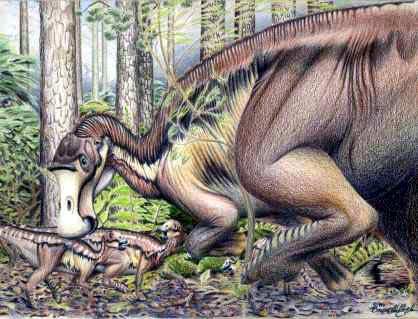
Kim Ann Zimmermann contributed to this article.
Related pages
- A Brief History of Dinosaurs
More dinosaurs
- Allosaurus: Facts About the 'Different Lizard'
- Ankylosaurus: Facts About the Armored Dinosaur
- Apatosaurus: Facts About the 'Deceptive Lizard'
- Archaeopteryx: Facts about the Transitional Fossil
- Brachiosaurus: Facts About the Giraffe-like Dinosaur
- Diplodocus: Facts About the Longest Dinosaur
- Giganotosaurus: Facts about the 'Giant Southern Lizard'
- Pterodactyl, Pteranodon & Other Flying 'Dinosaurs'
- Spinosaurus: The Largest Carnivorous Dinosaur
- Triceratops: Facts about the Three-horned Dinosaur
- Tyrannosaurus Rex: Facts about T. Rex, King of the Dinosaurs
- Velociraptor: Facts about the 'Speedy Thief'
Time periods
Precambrian: Facts About the Beginning of Time
Paleozoic Era: Facts & Information
- Cambrian Period: Facts & Information
- Silurian Period Facts: Climate, Animals & Plants
- Devonian Period: Climate, Animals & Plants
- Permian Period: Climate, Animals & Plants
Mesozoic Era: Age of the Dinosaurs
- Triassic Period Facts: Climate, Animals & Plants
- Jurassic Period Facts
- Cretaceous Period: Facts About Animals, Plants & Climate
Cenozoic Era: Facts About Climate, Animals & Plants
Quaternary Period: Climate, Animals & Other Facts
- Pleistocene Epoch: Facts About the Last Ice Age
- Holocene Epoch: The Age of Man
Additional resources
- Visit the American Museum of Natural History's permanent exhibition of Stegosaurus.
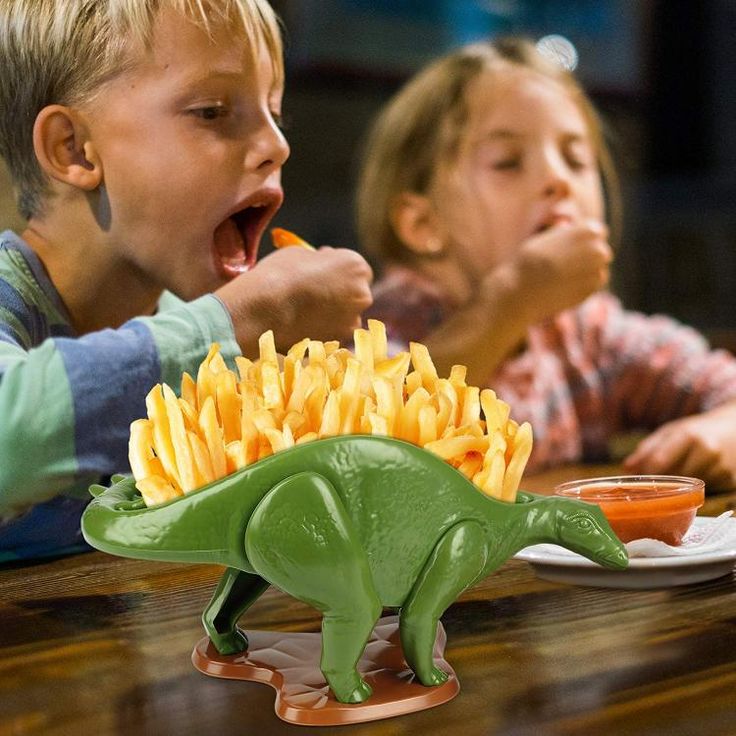
- Many specimens of Stegosaurus and other dinosaurs have been found at Dinosaur National Monument.
- Discover the "Last American Dinosaurs" at the Smithsonian's National Museum of Natural History.
Joseph Bennington-Castro is a Hawaii-based contributing writer for Live Science and Space.com. He holds a master's degree in science journalism from New York University, and a bachelor's degree in physics from the University of Hawaii. His work covers all areas of science, from the quirky mating behaviors of different animals, to the drug and alcohol habits of ancient cultures, to new advances in solar cell technology. On a more personal note, Joseph has had a near-obsession with video games for as long as he can remember, and is probably playing a game at this very moment.
Stegosaurus - herbivorous dinosaur
- BASIC FACTS
- Time of life and its habitat (period): Jurassic (155-145 million years ago), lived in the western United States (approximately the states of Wyoming and Colorado).
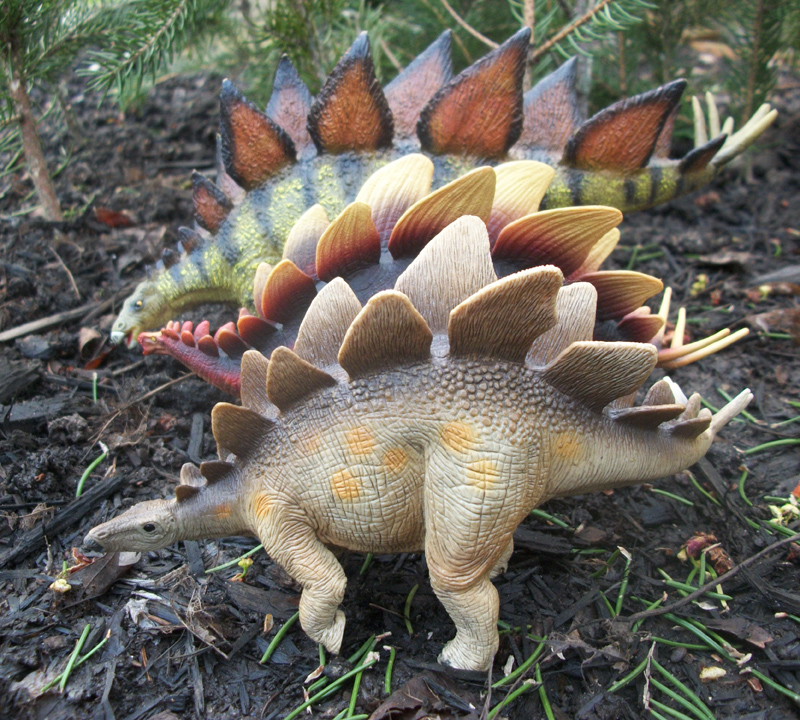
- Found: Colorado 19th century
- Kingdom: Animals
- Era: Mesozoic
- Type: Chordates
- Group: Ornithischian
- Subgroup: Thyreophores
- Class: Reptiles
- Superorder: Dinosaurs
- Infraorder: Stegosaurus
- Family: Stegosaurids
- Genus: Stegosaurus
A unique species of dinosaurs, which is remembered for its unusual body structure. On the back and tail, it has a kind of plate resembling poplar or laurel leaves (depending on the age of the dinosaur).
These dinosaurs were herbivores, moved on 4 legs, there are spikes and bone plates on the tail and back.
What did they eat and what kind of life did they lead
Stegosaurs used only vegetation, because. their teeth didn't allow them to chew anything harder. Stegosaurus also swallowed whole stones, which they rubbed leaves in the stomach and helped improve digestion.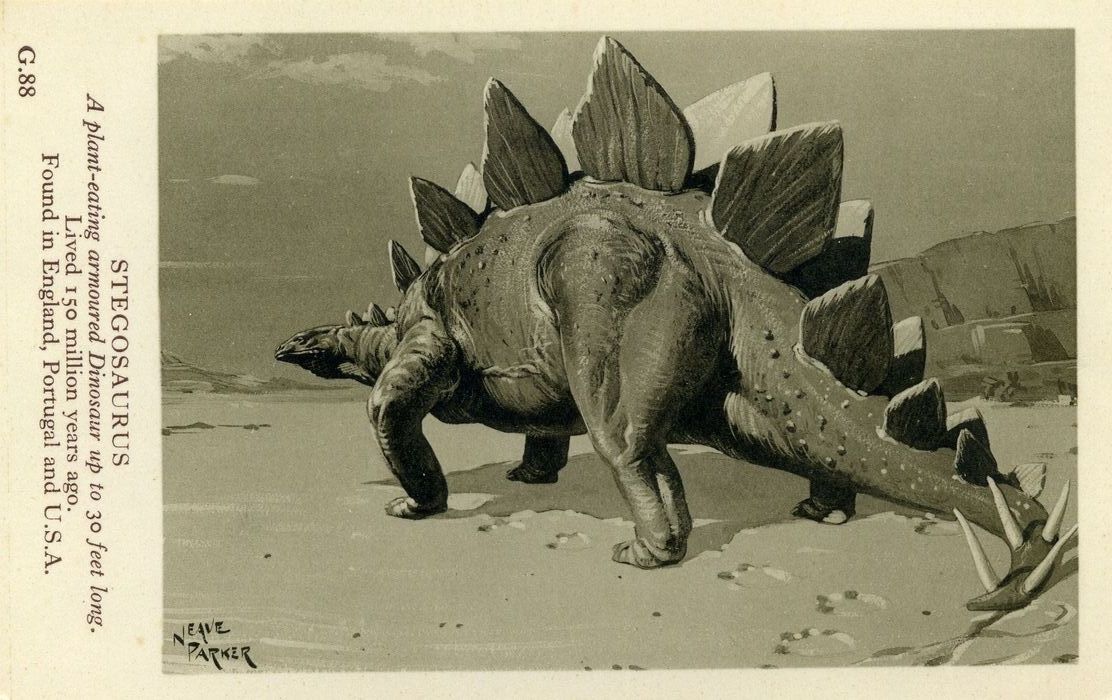
Body structure details
This dinosaur had excellent protection, solid bone outgrowths were located throughout the body, perfectly protecting its throat, legs and torso.
Plates of various sizes are arranged in 2 rows on the back, the largest plates grew up to 1m. They were not particularly durable and were used more for intimidation than protection. When an enemy appeared, the plates were painted red (the color of danger), which scared off predators, and also helped to compete for females with other males of this species. In addition, the back plates were a thermostat that accumulated heat and removed its excess.
But there were very sharp spikes on the tail, making a blow with the tail, it could stun its attacker and even kill. The number of such spikes could be up to 4 pieces, and their length was from 70 cm to 1 meter.
Dimensions
It reached a length of 9m (the largest stegosaurus was found in Arizona - 9m 79cm)
The height of the stegosaurus was no more than 4 m
Body weight - 5-7 tons
Stegosaurus head
The head was small, especially considering the enormous body of the dinosaur.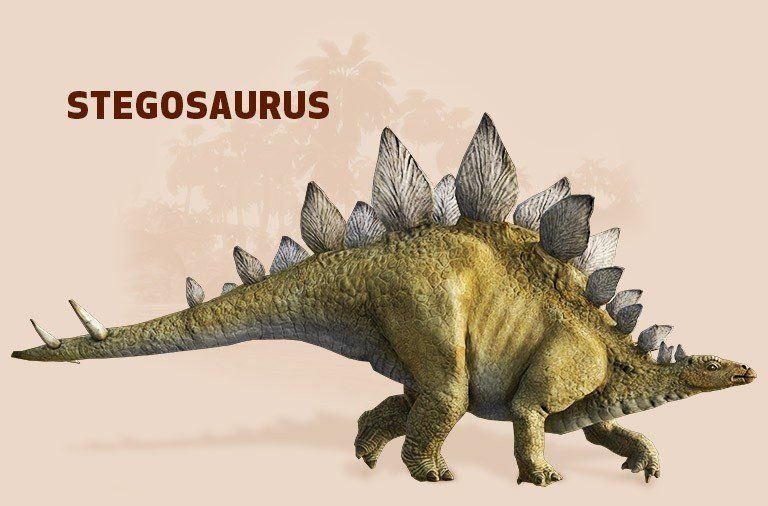 The skull did not exceed 40 cm in length.
The skull did not exceed 40 cm in length.
The brain also did not differ in large sizes - the size of a walnut.
Because of the underdeveloped jaws, only the tender leaves had to be eaten.
Limbs
They moved on 4 legs, the front ones, in comparison with the hind ones, were short and not so powerful. All the load came on the hind legs.
- Predatory neighbors:
- Allosaurus
- Albertosaurus
- Pterosaurus
- Tyrannosaurus
- Herbivorous neighbors:
- Diplodocus
- Brachiosaurus
- Hylaeosaurus
- Close kin groups:
- Vuerosaur
Video about stegosaurs (featuring Allosaurus)#1.
Video #2.
Video #3.
Photos and pictures
(click to enlarge) Buy silver chains and bracelets (male and female).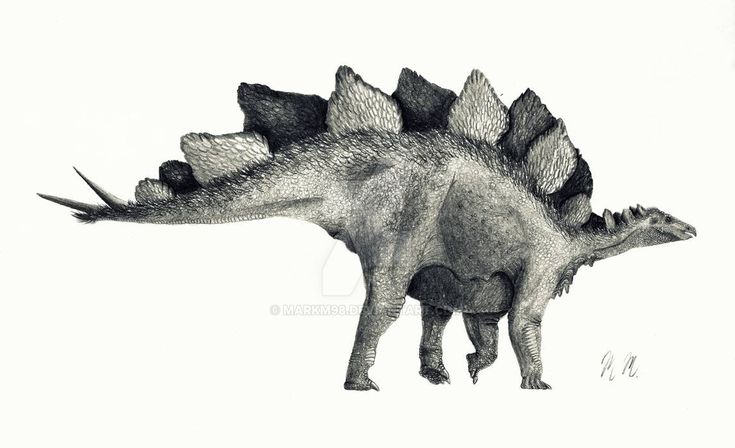
lion animal video
Average rating: 4.5
Total votes: 24
Dinosaur Stegosaurus. Report, message, photo, video
Stegosaurus belonged to the family of dinosaurs, which along the spine, from neck to tail, had a double row of bone plates. For the purpose of defense, he used his tail, which had sharp spikes at the end. Report-message with video and photo
Order - Ornithischians
Family - Stegosaurus
0118 Genus/Species - Stegosaurus stenops. Stegosaurus
Basic data:
DIMENSIONSLength: up to 9 m.
Weight: 6-8 tons.
Head length: about 45 cm.
The size of the brain: 3 cm.
Spinal plates: up to 60 cm.
9012
Mating period: time unknown; perhaps there were fights between males for the right to fertilize the female.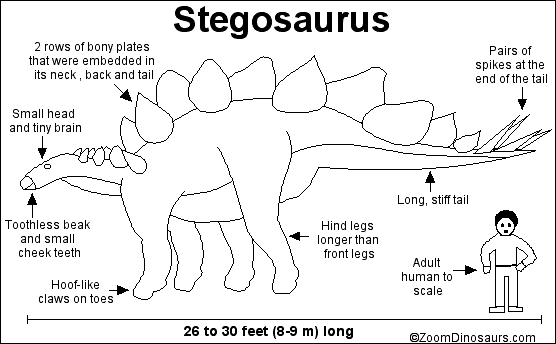
Laying time: probably several times a year.
LIFESTYLE
Habitat: Tropical.
Food: vegetation.
Habits: Stegosaurus (see picture) probably led a herd life.
RELATED SPECIES
A 5m long Kentrosaurus that lived in Africa.
Stegosaurus Dinosaur lived about 170 million years ago. Despite the intimidating appearance, he was a peaceful herbivore. It is likely that he lived in herds. They gave him security more by their numbers than by the militancy of the members of the herd.
FOOD
Stegosaurus was a herbivore and fed on many kinds of plants. In that historical period, a tropical climate prevailed on Earth in America, the earth was covered with lush vegetation.
Studies of Stegosaurus fossil skeletons have shown that Stegosaurus had fairly strong dorsal muscles associated with outgrowths on the hips at the base of the tail.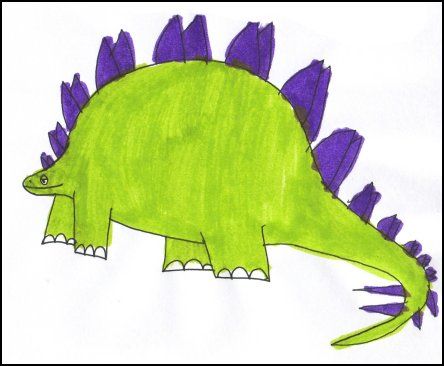 These muscles apparently allowed the Stegosaurus to stand up on its hind legs, thanks to which it reached plants that grew high. It is interesting to know that his body was not specially adapted to plant foods - his teeth were small and weak. It is believed that he, like other dinosaurs and modern crocodiles, swallowed stones to grind plant fibers.
These muscles apparently allowed the Stegosaurus to stand up on its hind legs, thanks to which it reached plants that grew high. It is interesting to know that his body was not specially adapted to plant foods - his teeth were small and weak. It is believed that he, like other dinosaurs and modern crocodiles, swallowed stones to grind plant fibers.
REPRODUCTION
One of the reasons why dinosaurs are so exciting is that very little is known about them. Therefore, you can always make some kind of discovery, and the finds can be hidden in the ground right under our feet.
Dinosaurs, including Stegosaurus, have been known to lay several relatively small eggs in shallow holes dug in the ground. They covered the eggs with sand so that the sun's rays warmed them. Newborn cubs grew very quickly, thereby avoiding the fate of becoming easy prey for predators.
During the defense against attackers, the cubs were placed in the center of the herd.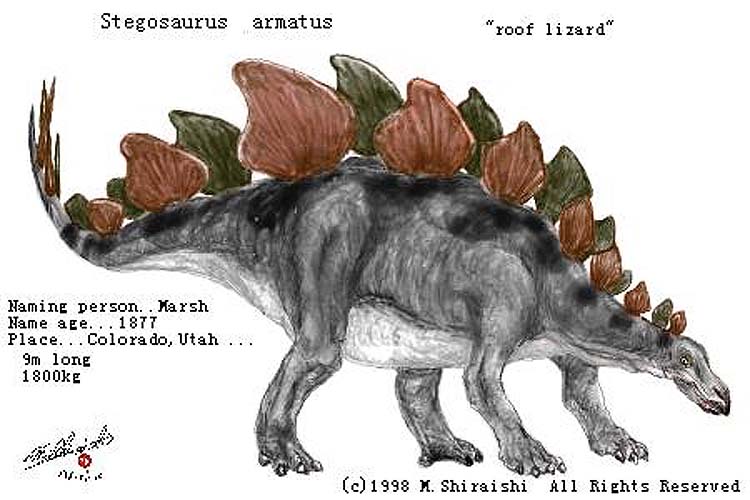 Since the Stegosaurus was a herd animal, the males competed for the right to possess the female and be the leader of the herd. In such situations, herbivores only make threatening sounds and demonstrate their strength to other males, but do not enter into an open fight.
Since the Stegosaurus was a herd animal, the males competed for the right to possess the female and be the leader of the herd. In such situations, herbivores only make threatening sounds and demonstrate their strength to other males, but do not enter into an open fight.
ENEMIES
The peaceful Stegosaurus often fell prey to carnivorous dinosaurs such as the dangerous Tyrannosaurus Rex.
Stegosaurus was most likely rather slow and defenseless, especially when attacked from the side and in the leg area. He was slow and therefore could not run away from predators. He defended himself by unexpectedly hitting the attacker with his tail, which was covered with spikes. Each of the spikes on the tail was about 1 m long. Stegosaurus had two pairs of them.
Some species related to Stegosaurus had four pairs of spines. The spikes were quite keratinized and could seriously injure the enemy if he fell into their reach.
SPECIAL SIGNS.
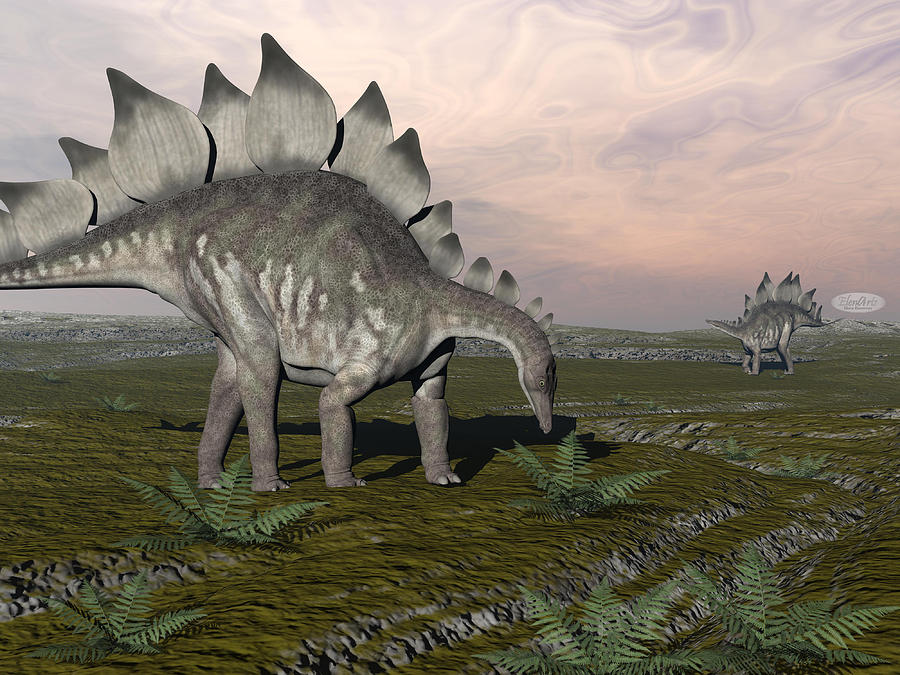 DESCRIPTION
DESCRIPTION Stegosaurus belongs to the dinosaurs that have a double row of bony plates along the spine on the back.
There are many theories that try to explain the purpose of the plates, the tallest of which is 60 cm high. Some argue that the plates were needed for self-defense. According to other theories, they served to regulate the temperature.
If the plates were covered with skin with many blood vessels, then, being turned towards the sun, they could serve the animal for heating the body, and when placed in the shade, they cooled the body.
Stegosaurus had four spikes at the end of its tail, which it apparently used to protect itself.
Stegosaurus did not belong to the largest dinosaurs, however, its body length reached 9 meters. The forelimbs were half as long as the hind ones, so the stegosaurus moved by leaning forward strongly.
The head of the stegosaurus was very small, about 45 centimeters long, and almost touched the ground.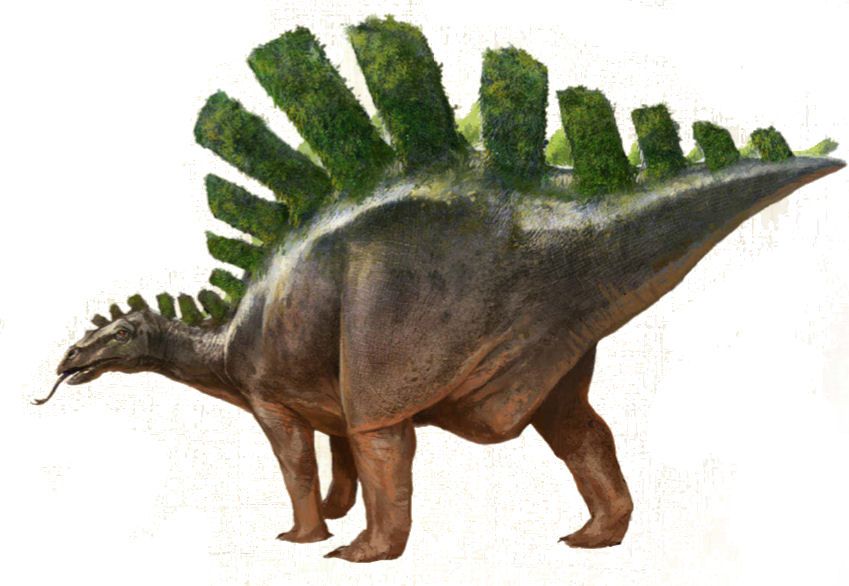 Its brain was also small - only about 3 cm.
Its brain was also small - only about 3 cm.
At that time, a warm, almost tropical climate prevailed there - ideal for such herbivorous dinosaurs as the Stegosaurus. The vegetation that grew on the continent, at first glance, resembled a modern rainforest, but today's plant species did not exist at that time. So, there were no flower plants. Everywhere, next to ferns and coniferous trees, ancient palm trees grew, which, in their appearance, resembled modern ones.
INTERESTING INFO. DID YOU KNOW THAT...
- Fossilized remains of a relative of the Stegosaurus have been found in Western Europe.
- Stegosaurs apparently lived for a short time in the Jurassic. The remains of these dinosaurs are found only in the upper layers of rocks.
- Some modern reptiles look like smaller versions of extinct dinosaurs.
- A lizard that lives in Africa has spikes on its head and body similar to those on a Stegosaurus. However, this lizard is 60 times smaller than a Stegosaurus, and its length reaches only 60 cm.
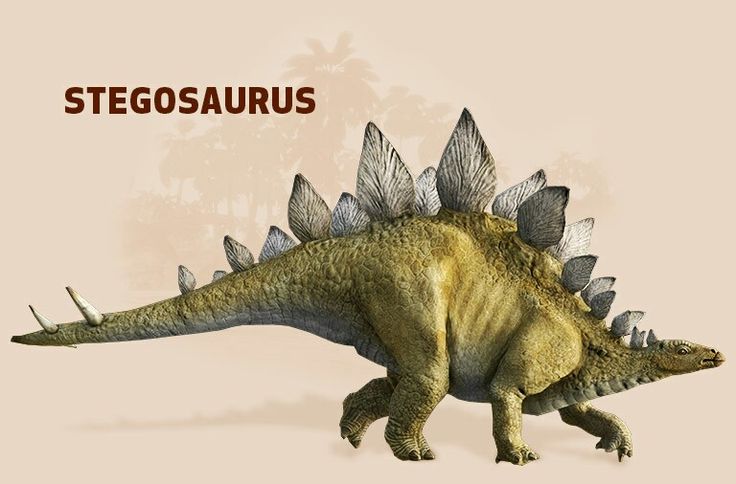
STEGOSAUR FEATURES
Dorsal plates: ran from head to tip of tail. There are many theories that explain their purpose, including one that suggests that they served to regulate body temperature.
Head: small compared to large body. The brain is the size of a walnut.
Forelegs: much shorter than the hind legs, designed for walking.
Hindquarters: strong, able to bear the weight of the entire body of the animal.
WHERE AND WHEN THE STEGOSAUR LIVED
The Stegosaurus dinosaur lived in the late Jurassic period 170 million years ago in North America. Its fossilized footprints have been found in Colorado, Oklahoma, Utah, and Wyoming. It is not uncommon for Stegosaurus footprints to be found in large numbers and extend for many kilometers. Other members of the Stegosaurus family lived in places like Western Europe, East Asia, and East Africa.